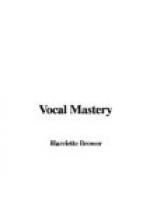“Do not tamper with the two or three extreme upper or lower tones of your voice lest you strain and ruin it permanently. Never practice when suffering from a cold.
“Ideal attack is the tone which starts without any scooping, breathiness or explosiveness. Breathe noiselessly, the secret of which is to breathe from down, up. Faulty emissions of tone are: nasal, guttural, throaty and tremulous. I will give you examples of all these from the record No. 33, which will show you first the fault and then the perfect example. If the pupil studies these perfect emissions of tone and tries to imitate them, there is no need for her to have the common faults mentioned.
SUSTAINED TONES
“The next step is to study sustained tones. As you see the artist begins in the middle of her voice—always the best way—and sings a whole tone on A, with the syllable Ah, always waiting a whole measure for the pupil to imitate the tone. Next she sings A flat and so on down to lower A, the pupil imitating each tone. She now returns to middle A and ascends by half steps to E natural, the pupil copying each tone after it is sung by the artist.
“The tone should be free, round and full, but not loud, and the aim be to preserve the same quality throughout. Do not throw or push the tone, but spin it.
UNITING SEVERAL TONES
“We first begin by uniting two tones, smoothly and evenly, then three in the same way. After each pair or group of tones, the accompaniment is repeated and the pupil imitates what the artist has just sung. Now comes the uniting of five tones, up and down; after this the scale of one octave. The scale should be sung easily with moderate tone quality. A slight accent can be given to the first and last tones of the scale. We all realize the scale is one of the most important exercises for the building of the voice; the preceding exercises have prepared for it.
ARPEGGIOS
“For imparting flexibility to the voice, nothing can exceed the Arpeggio, but like all vocal exercises, it must be produced with precision of tone, singing each interval clearly, with careful intonation, always striving for beauty of tone.
“There are various forms of arpeggios to be used. The second form is carried a third above the octave; the third form a fifth above. This makes an exercise which employs every tone in the scale save one, and gives practice in rapid breathing. Remember, that the note before, taking breath is slightly shortened, in order to give time for taking breath, without disturbing the rhythm.
THE TRILL
“The trill is perhaps the most difficult of all vocal exercises, unless the singer is blessed with a natural trill, which is a rare gift. We begin with quarter notes, then add eighths and sixteenths. This exercise, if practiced daily, will produce the desired result. It is taken on each tone of the voice—trilling in major seconds.




